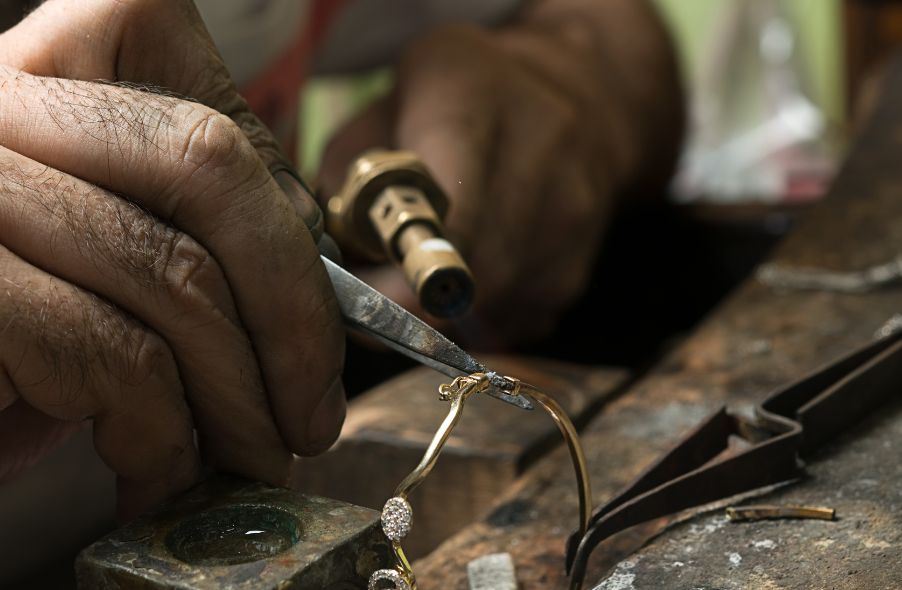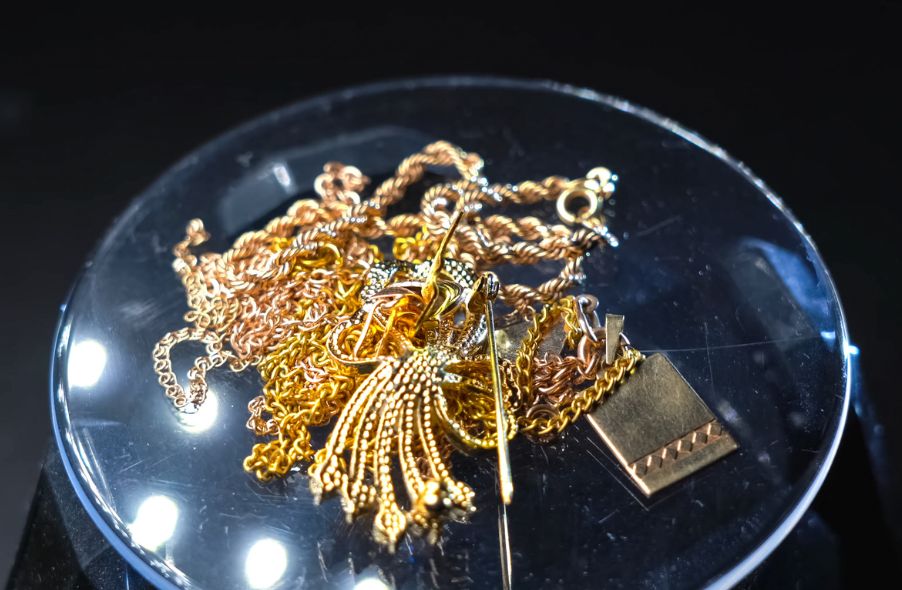
When you see a beautiful gold necklace in a jeweler's shop, how can you be certain if it is made of real gold or if it is just designed to look like gold? Many reputable retailers use real gold in their jewelry, but there are two terms that are often used to describe the way gold is incorporated into the jewelry: "gold-filled" and "gold-plated."
In this guide, we will help you understand the difference between gold-filled and gold-plated jewelry, including their pricing and maintenance requirements. By the end of this detailed explanation, you will have a better understanding of which type of jewelry suits your needs.
What Is Gold-Filled Jewelry?
If you come across a ring listed as gold-filled while browsing for jewelry online, you might assume that the entire piece is made of pure gold. However, this is not the case. Gold-filled jewelry actually consists of two layers of gold mixed with other metals such as brass or copper.
The process of making gold-filled jewelry involves chemically bonding either 12-karat or 14-karat gold to another metal using high-power machinery. This process involves high heat and pressure to bond a bottom layer of gold, followed by a core layer of another metal, and finished off with a top layer of gold.
Gold purity is measured in karats on a scale that goes up to 24, where 24 signifies 100% solid gold. Gold-filled items with 12-karat gold means that only 50% of the precious metal alloy is pure gold.
Making gold-filled jewelry is a complex and often expensive process. Many small jewelry stores do not have the machinery required to bond gold and other metals, so they rely on mass-produced products. This can make it more difficult to find gold-filled jewelry in certain stores.
Retailers cannot classify any piece with a small amount of gold as gold-filled. They must ensure that the gold layers make up at least 5% of the total metal content. These layers contribute to the overall thickness and durability of the jewelry.
What Is Gold-Plated Jewelry?
Gold-plated jewelry also features a layer of gold over another metal, such as sterling silver or brass. However, gold-plated jewelry contains a much smaller amount of gold and is more prone to tarnishing. The process of making gold-plated and gold-filled jewelry also differs.

Many jewelers do not have the resources to produce gold-filled jewelry, so they opt for gold-plated options instead. Here are the steps involved in making gold-plated jewelry:
- Gather gold pieces, a base metal, and a liquid electroplating solution.
- Let the gold and base metal soak in the electroplating solution.
- Bond the two metals by sending a positive electric current to the gold and a negative current to the base metal.
- Mold the piece into the desired design.
This process is much simpler for jewelers to perform on their own and allows them more freedom and creativity in their designs.
Composition and Durability of Gold-Filled Jewelry
When comparing gold-filled and gold-plated jewelry, the former is much more durable. Gold-filled objects like rings, necklaces, and bracelets do not tarnish or scratch easily with daily wear because they contain a larger amount of gold. If you plan to wear jewelry daily, especially in situations where it may come into contact with sweat, water, lotions, and other substances, it is advisable to choose gold-filled jewelry.
While gold-filled jewelry will eventually tarnish down to the base metal after several years of use, the timeline may vary depending on the percentage of gold in the piece and its karat measurement. An item that contains 5% 14-karat gold will likely tarnish faster than an item that contains 8% 24-karat gold.
Although gold-filled jewelry has better composition and durability compared to gold-plated jewelry, there are instances where it is better to opt for the more expensive option of solid gold. For example, if you are shopping for a wedding band, a gold-filled ring may not last as long before tarnishing. In this case, it is better to invest in a solid gold ring for a piece of jewelry that will endure a long marriage.
Composition and Durability of Gold-Plated Jewelry
Gold-plated jewelry is the least durable option when compared to solid gold or gold-filled jewelry. Many people find that gold-plated jewelry leaves a green mark on their skin after wearing it for a day. This is because gold-plated jewelry has poor tarnish resistance.
Unlike gold-filled jewelry, gold-plated objects do not have a specific requirement for the amount of gold they contain. Instead, they have a thin layer of gold that is typically too small to measure. A gold-plated piece of jewelry may contain less than 0.05% gold and have a thickness between 0.175 and 2.5 microns.
This ultra-thin coating over the base metal will tarnish easily, especially when exposed to water, chemicals, lotions, and other elements. If you have metal allergies or sensitivity to base metals like brass or copper, it is important to be cautious when wearing gold-plated jewelry.

Difference in Price
Before purchasing any type of gold jewelry, it is important to consider your budget and how much you are willing to spend. The average price of pure gold in 2023 is $1,933.02 per ounce. The price of gold-filled and gold-plated jewelry varies based on the gold content, among other factors.
Gold-filled jewelry is generally more expensive due to the complexity and cost of the manufacturing process. However, it still offers the appearance and durability of solid gold at a lower price range, typically between $30 and $100.
On the other hand, gold-plated jewelry is more affordable since it contains only a small amount of gold. Many gold-plated pieces sell for prices ranging from $10 to $50.
Keep in mind that the price of similar products can vary significantly depending on the retailer. A gold-filled ring from a small boutique may cost more than a similar ring from a larger store. Retailers often set prices based on their inventory and branding, regardless of the gold content or style of the jewelry.
Difference in Appearance
Is it possible to identify gold-filled and gold-plated jewelry based on their appearance alone? At first glance, two gold rings may look similar in a jewelry case. However, upon closer inspection, there are subtle differences between gold-filled and gold-plated jewelry.
Each type of jewelry has a different composition, which affects its flexibility. Gold-plated jewelry is usually more flexible due to its thin layer of gold. Gold-filled pieces, on the other hand, are generally sturdier since they contain at least 5% gold.
For a more conclusive distinction, you can use a magnifying glass. Most gold-filled pieces have a stamped appearance and contain markings indicating the karat measurement and "GF" to signify that it is gold-filled.
Care and Maintenance of Gold-Filled Jewelry
The care and maintenance of gold-filled jewelry differ slightly from gold-plated jewelry. Gold-filled items tarnish at a slower rate and are suitable for daily wear. However, it is important to avoid exposing your jewelry to moisture, especially when swimming in saltwater or chlorine-filled pools.
Exposure to harsh elements and moisture can damage gold-filled jewelry. Even sweating or leaving the jewelry in excessive humidity can speed up the tarnishing process. To keep your gold-filled jewelry in the best condition, regularly clean it with a jewelry-safe polish and wipe it for a fresh shine.
Care and Maintenance of Gold-Plated Jewelry
Many of the same maintenance requirements for gold-filled jewelry apply to gold-plated jewelry. In addition to keeping your jewelry dry, it is important to avoid harsh chemicals that can damage the thin layer of gold. Here are some products to keep your gold-plated jewelry away from to prevent tarnishing:
- Household cleaning products
- Lotions
- Perfumes
- Hairsprays
After wearing your gold-plated jewelry, gently wipe it with a cloth to remove dirt and oils. You can soak the piece in a solution of warm water and a few drops of dish soap or use a cotton swab dipped in the solution to clean the jewelry.
Consider Solid Gold
If you find it difficult to choose between gold-filled and gold-plated jewelry, and if their limitations are not acceptable to you, solid gold may be the best option. Solid gold jewelry is more expensive, but it offers higher quality and durability. Solid gold jewelry does not tarnish and can resist scratches and impacts.
Unlike gold-filled or gold-plated jewelry, solid gold jewelry contains only gold without any other metals. This makes it a safer option for those with sensitive skin or metal allergies. Solid gold jewelry will last a lifetime and maintain its appearance, even with daily wear. You won't have to deal with chipped material or green marks on your skin when you invest in solid gold jewelry.
It is important to note that solid gold jewelry is the most expensive option available. If your budget does not allow for solid gold, you may consider purchasing gold-filled jewelry as a more affordable alternative that offers similar appearance and durability.
Vermeil Gold
In discussions about gold-filled and gold-plated jewelry, you may come across the term vermeil gold. Vermeil gold plating follows the same plating processes as gold-plated jewelry but uses 10-karat gold and sterling silver as a base metal. This option is suitable for those who are allergic to nickel, brass, or other alloy metals used in the plating process.
Vermeil gold is less prone to tarnishing due to the durability of sterling silver. The cost of vermeil gold jewelry is comparable to that of gold-plated jewelry that uses copper, brass, or nickel. However, it is important to remember that lower costs may indicate lower quality. It is advisable to avoid exposing vermeil gold jewelry to water, chemicals, lotion, and other harmful elements to prevent tarnishing.
Understanding the value retention and pricing of gold-filled vs. gold-plated jewelry will help you make an informed decision when purchasing jewelry. If you want to expand your knowledge of gold and explore the benefits of investing in gold, consider opening a gold IRA. Contact the specialists at Learn About Gold for more information about investing in various gold products.
Frequently Asked Questions
Is it possible to make money with a gold IRA.
If you want to make money on an investment, you need to do two things firstly, understand how the market operates, and secondly, know what kind of products are available.
If you don't know, you shouldn't start trading until you are sure you have enough information to trade successfully.
Find a broker that offers the best service to your account type.
You can choose from a variety of accounts, including Roth IRAs or standard IRAs.
If you have other investments such as bonds or stocks, you might also consider a rollover.
Is it possible to take physical ownership of gold from my IRA
Many people are curious if they can possess physical gold in an IRA. This is a valid question as there is no legal route to it.
You can still own gold in an IRA if you look at the law.
The problem is that most people don't realize how much money they could save by putting their gold in an IRA instead of keeping it in their own homes.
It is easy to toss gold coins, but it's not easy to place them in an IRA. If you decide that you want to keep your gold at home, you'll be responsible for two tax payments. Two taxes will be charged: one to the IRS, one to the state you live in.
It is possible to lose your gold and pay twice as much tax. So why would anyone want to keep their gold in their home?
You might argue that it is important to know that your gold remains safe in your house. You can protect your gold from theft by storing it somewhere more secure.
If you intend to visit often, don't leave your gold unattended in your home. If you leave your gold unattended, thieves can easily steal it while you're out of town.
You can store your gold in an insurance vault. Your gold will be safe from fire, flood and earthquake as well as robbery.
Another advantage to storing your gold in a vault is that you won't have to worry about paying property tax. Instead, any gains that you make by selling your gold will be subject to income tax.
An IRA is a way to avoid paying taxes on gold. You won't be subject to income tax if you earn interest from your gold with an IRA.
Capital gains tax is not required on gold. If you decide to cash it out, you will have full access to its value.
Because IRAs have federal regulation, it won't be difficult to transfer your gold to another bank if there is a move.
Bottom line: You can have gold in an IRA. Your fear of it being stolen is what holds you back.
How do I choose the right IRA for me?
Understanding your account type will help you find the right IRA. This includes whether you are looking for a traditional IRA or Roth IRA. Also, you should know how much money is available for investment.
Next is deciding which provider best suits your needs. Some providers offer both accounts, while others specialize in just one type.
Consider the fees that come with each option. Fees may vary from one provider to another and could include annual maintenance fees as well. One example is that some providers charge a monthly subscription based upon the number of shares you hold. Others charge only once per quarter.
Which is better: sterling silver or 14k-gold?
Sterling silver, which contains 92% pure sterling silver instead of just 24%, is a stronger metal than gold or silver.
Sterling silver, also known as fine or sterling silver, is made of a combination of silver and other metals like copper and zinc.
It is generally believed that gold is very strong. It is very difficult to separate it from its metal counterpart. If you dropped an object onto a piece or gold, it would break into thousands instead of two halves.
Silver isn't nearly as strong as either gold or silver. If you dropped an object onto a sheet silver, it would bend and fold with no damage.
It is commonly used in coins and jewelry. Silver's value can fluctuate depending on the supply and demand.
How does an IRA for gold and/or silver work?
An IRA for gold and/or silver allows you to invest without tax in precious metals such as silver and gold. People who want to diversify portfolios will find them attractive investments.
If you're over 59 1/2, you don't have to pay income taxes on interest earned through these accounts. Any appreciation in the account's worth does not attract capital gains tax. However, there are limitations on how much money you can put into this type of account. The minimum amount is $10,000. If you're under the age of 59 1/2, investing is not allowed. The maximum annual contribution is $5,000.
If you die prior to retirement, your beneficiaries may not receive the full amount. After you have paid all your expenses, your estate should include sufficient assets to cover the balance of your account.
Some banks offer a gold or silver IRA option, while others require that you open a regular brokerage account where you can buy certificates or shares.
Statistics
- The maximum yearly contribution to an individual's IRAs is currently $6,000 ($7,000 for those 50 years or older), or 100% of earned income, whichever is less. (monex.com)
- Silver must be 99.9% pure • (forbes.com)
- To qualify as IRA allowable precious metals and be accepted by STRATA, the following minimum fineness requirements must be met: Gold must be 99.5% pure, silver must be 99.9% pure, and platinum and palladium must both be 99.95% pure. (stratatrust.com)
- The IRS also allows American Eagle coins, even though they do not meet gold's 99.5% purity standard. (forbes.com)
External Links
regalassets.com
en.wikipedia.org
wsj.com
forbes.com
- Gold IRA: Add Some Sparkle To Your Retirement Nest Egg
- Understanding China's Evergrande Crisis – Forbes Advisor
How To
Precious Metals Approved by the IRA
IRA-approved metals are great investments. You have many options to diversify your portfolio, protect yourself against inflation, and from silver coins to gold bars, there are many.
Precious Metal Investment Products come in two main formats. Physical bullion products such bars or coins are considered to be physical assets, as they exist in tangible form. Exchange-traded funds (ETFs), on the other side, are financial instruments which track the price movements for an underlying asset like gold. ETFs can be purchased directly from the company issuing them, and trade in the same way as stocks on stock exchanges.
There are many types of precious metals that you can purchase. Silver and gold are frequently used for ornaments and jewelry making, while palladium and platinum are more often associated with luxury items. Palladium has a tendency to retain its value longer than platinum making it an ideal choice for industrial uses. While silver can be used for industrial purposes, it is more commonly preferred for decorative purposes.
Due to the high cost of refining and mining raw materials, physical bullion products are more expensive. But, they are generally more secure than paper currencies and provide buyers greater security. Consumers may lose faith in the currency and seek out alternatives if the U.S. dollar falls in purchasing power. In contrast, physical bullion products do not rely on trust between countries or companies. Instead, they have the backing of central banks and governments. This gives customers confidence.
Gold prices fluctuate based on supply and demand. Demand rises, and the price goes up. On the other hand, supply falls when demand exceeds demand. This dynamic creates opportunities for investors to profit from fluctuations in the price of gold. These fluctuations are good for investors who have physical bullion products as they get a better return on their investment.
Contrary to traditional investments, precious metals can not be affected by economic recessions and interest rate changes. As long demand is strong, gold prices will continue to climb. Precious metals, which are safe havens for times of uncertainty, are therefore considered to be safe havens.
The most popular precious metals include:
- Gold – Gold is the oldest type of precious metal and is often called “yellow metal.” Although gold is a common household name, it is a very rare element found naturally underground. Most of the gold reserves in the world are located in South Africa.
- Silver – After gold, silver is the second most precious precious metal. Silver can be mined from naturally occurring deposits, much like gold. Silver is extracted from ore, not rock formations, unlike gold. Due to its durability and conductivity as well as its resistance to tarnishing it is widely used for commerce and industry. Over 98% of global silver production is produced in the United States.
- Platinum – Platinum is the third most valuable precious metal. It is used in many industries, such as fuel cells, catalytic converters and high-end medical equipment. Platinum is also used in dentistry to make dental crowns, fillings, and bridges.
- Palladium – Palladium ranks fourth in the list of most valuable precious metals. Its popularity is growing rapidly among manufacturers because of its strength and stability. Palladium can also be used in electronics, military technology, and automobiles.
- Rhodium – Rhodium has been ranked fifth among precious metals. Although rhodium is extremely rare, it is highly sought after because of its use in automobile catalysts.
- Ruthenium – Ruthenium ranks sixth in the list of most valuable precious metals. Although there is a limited supply of palladium and platinum, ruthenium can be found in abundance. It is used to make steel and engines for aircraft, as well chemical manufacturing.
- Iridium – Iridium is the seventh most valuable precious metal. Iridium is a key component in satellite technology. It is used in the construction of orbiting satellites that transmit TV signals and telephone calls.
- Osmium (Osmium) – Osmium has the eighth highest value precious metal. Osmium's ability to withstand extreme temperatures makes it a common metal in nuclear reactors. Osmium is used in medicine, cutting tools, jewelry, as well as medicine.
- Rhenium – Rhenium is the 9th most valuable precious metal. Rhenium is used in refining oil and gas, semiconductors, and rocketry.
- Iodine — Iodine has the highest value of all precious metals. Iodine is used in photography, radiography, and pharmaceuticals.
—————————————————————————————————————————————————————————————-
By: Learn About Gold
Title: Understanding Gold-Filled vs. Gold-Plated Jewelry
Sourced From: learnaboutgold.com/blog/gold-filled-vs-gold-plated/
Published Date: Sun, 24 Sep 2023 23:14:10 +0000



















